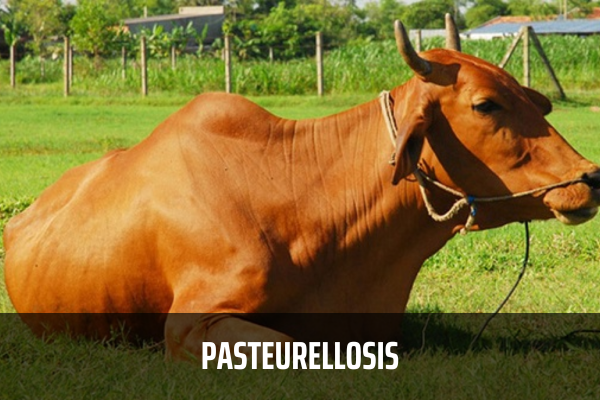What time of year are cattles most susceptible to pasteurellosis? What clinical symptoms will cattles have when infected with pasteurellosis?
What time of year are cattles most susceptible to pasteurellosis?
Pursuant to subsection 6.1 of Section 6 of Vietnam's National Standard TCVN 8400-56:2023 on Animal disease - Diagnostic procedure - Part 56: Pasteurellosis in swine, cattle, poultry, the epidemiological characteristics of Pasteurellosis are as follows:
Clinical diagnosis
6.1 Epidemiological characteristics
Pasteurellosis is an infectious disease that affects many animal species, commonly found in swine, water buffalo, cattle, and poultry. The disease usually occurs in an acute form. In swine, water buffalo, and cattle, the disease is caused by P. multocida type A, characterized by fever and pneumonia; in swine, water buffalo, and cattle, the disease is caused by P. multocida type B, characterized by hemorrhage and septicemia; in poultry, the disease is caused by P. multocida type A, characterized by diarrhea and swine-like feces.
Animals of all ages can be affected by Pasteurellosis. Water buffalo and cattle are commonly affected at the age of 2 to 3 years; swine are commonly affected at the age of 16 to 18 weeks; poultry are commonly affected at the age of 3 to 4 weeks.
Pasteurellosis can occur throughout the year, but it is most commonly observed during the transitional seasons. In the northern region, it occurs during the transition from spring to summer and from autumn to winter; in the southern region, it occurs during the transition from the rainy season to the dry season and vice versa.
The disease can be transmitted directly from sick animals to healthy ones through contact, respiratory route, or indirectly through food, water, farming tools, transportation, and intermediate hosts such as dogs, cats, mice, insects, flies, mosquitoes, and ticks.
...
Pasteurellosis can occur throughout the year, but it is most commonly observed during the transitional seasons. In the northern region, it occurs during the transition from spring to summer and from autumn to winter; in the southern region, it occurs during the transition from the rainy season to the dry season and vice versa.
Animals of all ages can be affected by Pasteurellosis. Cattle are commonly affected at the age of 2 to 3 years.
The disease usually occurs in an acute form. In cattle, the disease is caused by P. multocida type B, characterized by hemorrhage and septicemia

What time of year are cattles most susceptible to pasteurellosis? (Image from the Internet)
What clinical symptoms will cattle have when infected with pasteurellosis?
Pursuant to point 6.2.2, subsection 6.2, Section 6 of the Vietnam's National Standard TCVN 8400-56:2023 on Animal disease - Diagnostic procedure - Part 56: Pasteurellosis in swine, cattle, and poultry, the clinical symptoms of cattle affected by pasteurellosis are divided into three forms:
- Extremely acute form:
This form is rare. Cattle rapidly develop the disease, with high fever ranging from 41 °C to 42 °C, and they die within 24 hours. Cattle show neurological symptoms such as madness, aggression, staggering, trembling, convulsions, etc.
- Acute form:
This form is common. The incubation period ranges from 1 to 3 days, and cattle have a high fever ranging from 40 °C to 42 °C.
They have continuous tearing and nasal discharge. The mucous membranes of the eyes, nose, and mouth become reddish and then dark in color.
Lymph nodes, especially the submaxillary lymph nodes, swell, causing the tongue to protrude and difficulty in breathing. Swollen pre-thigh lymph nodes make it difficult for cattle to move.
Cattle become recumbent, urinate blood, have difficulty breathing, and have dark spots on the mucous membranes. Death occurs within 3 to 5 days, with a mortality rate of up to 100%.
- Chronic form:
This form is very rare and develops if cattle do not die from the acute form. Cattle have difficulty in movement, chronic joint inflammation, chronic bronchitis and pneumonia, and chronic enteritis characterized by alternating constipation and diarrhea.
Vietnam: If cattle have clinical symptoms of pasteurellosis, how to take diagnostic samples?
Pursuant to section 7.1.1, subsection 7.1, Section 7 of the Vietnam's National Standard TCVN 8400-56:2023 on Animal disease - Diagnostic procedure - Part 56: Pasteurellosis in swine, cattle, and poultry, the sampling procedure for diagnosing pasteurellosis in cattle showing signs of the disease is as follows:
* For suspected live cattle: take samples of upper respiratory tract secretions or blood samples with anticoagulants.
- Respiratory tract secretions: Use a swab to collect nasal or pharyngeal secretions. Place the swab in a test tube containing physiological saline solution, seal it tightly, and label it.
- Blood sample with anticoagulant: Disinfect the blood sampling site with 70% alcohol. Use a syringe and needle to collect about 1 ml to 3 ml of blood from a vein. Transfer the blood to a test tube that already contains an anticoagulant, gently mix it for 10 seconds, seal it tightly, and label it.
* For deceased cattle or cattle requiring postmortem examination
To examine lesions, the sampling of pathological specimens should follow the guidelines of TCVN 8402:2010 on techniques for sampling, preservation, and transportation of animal pathological specimens on land. The specimens include lungs, liver, spleen, heart blood, pericardial fluid, and bone marrow.
- Lung, liver, spleen sampling: Use a scalpel or scissors to cut 10 g to 100 g of each specimen. Place them in separate sterile jars or bags, seal them tightly, and label them.
- Heart blood, pericardial fluid sampling: Use a syringe and needle or pipette to collect heart blood and pericardial fluid. Keep the sample in the syringe or transfer it to a separate sterile jar, seal it tightly, and label it.
- Bone marrow: Remove the meat from the bone, place the bone marrow in separate sterile bags, seal them tightly, and label them.
LawNet